
- CN 62-1070/P
- ISSN 1000-694X
- Bimonthly 1981

Journal of Desert Research ›› 2023, Vol. 43 ›› Issue (4): 76-88.DOI: 10.7522/j.issn.1000-694X.2022.00160
Previous Articles Next Articles
Kader Mavlan1,2( ), Lu Zhang3, Xinhua Liu2(
), Lu Zhang3, Xinhua Liu2( ), Tunyaz Nurbiye4, Muming Gulnafar5, Shaobo Gao6
), Tunyaz Nurbiye4, Muming Gulnafar5, Shaobo Gao6
Received:2022-09-09
Revised:2022-12-01
Online:2023-07-20
Published:2023-08-14
Contact:
Xinhua Liu
CLC Number:
Kader Mavlan, Lu Zhang, Xinhua Liu, Tunyaz Nurbiye, Muming Gulnafar, Shaobo Gao. Comparative analysis of two dust weather processes in Tarim Basin, China[J]. Journal of Desert Research, 2023, 43(4): 76-88.
Add to citation manager EndNote|Ris|BibTeX
URL: http://www.desert.ac.cn/EN/10.7522/j.issn.1000-694X.2022.00160
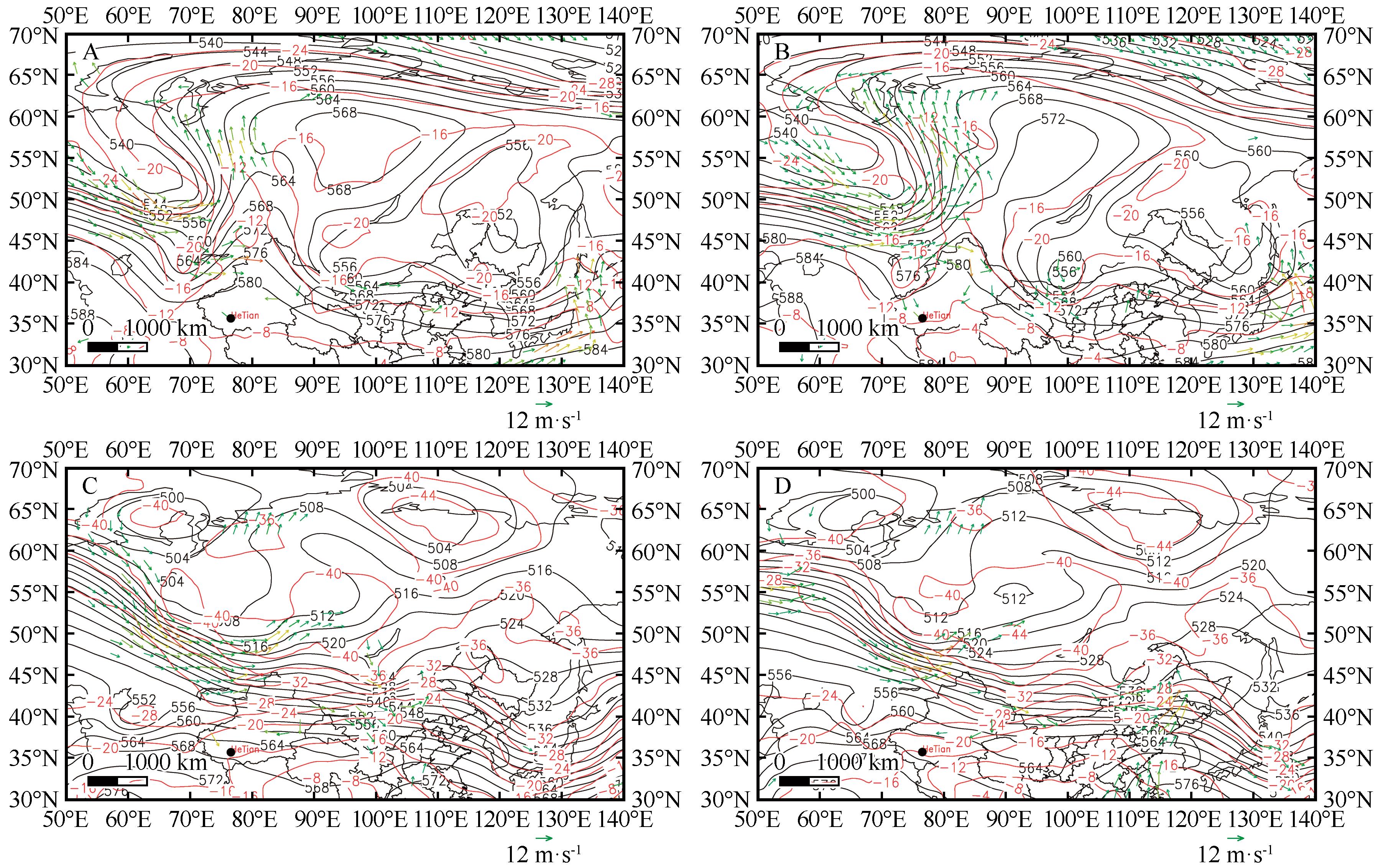
Fig. 2 500 hPa height field (black isoline, unit: gpm), temperature field (red isoline, unit: °C) and 850 hPa wind field at 08:00 (A), 20:00 (B) on 9 June, 2015 and at 08:00 (C), 20:00 (D) on 24 March, 2022
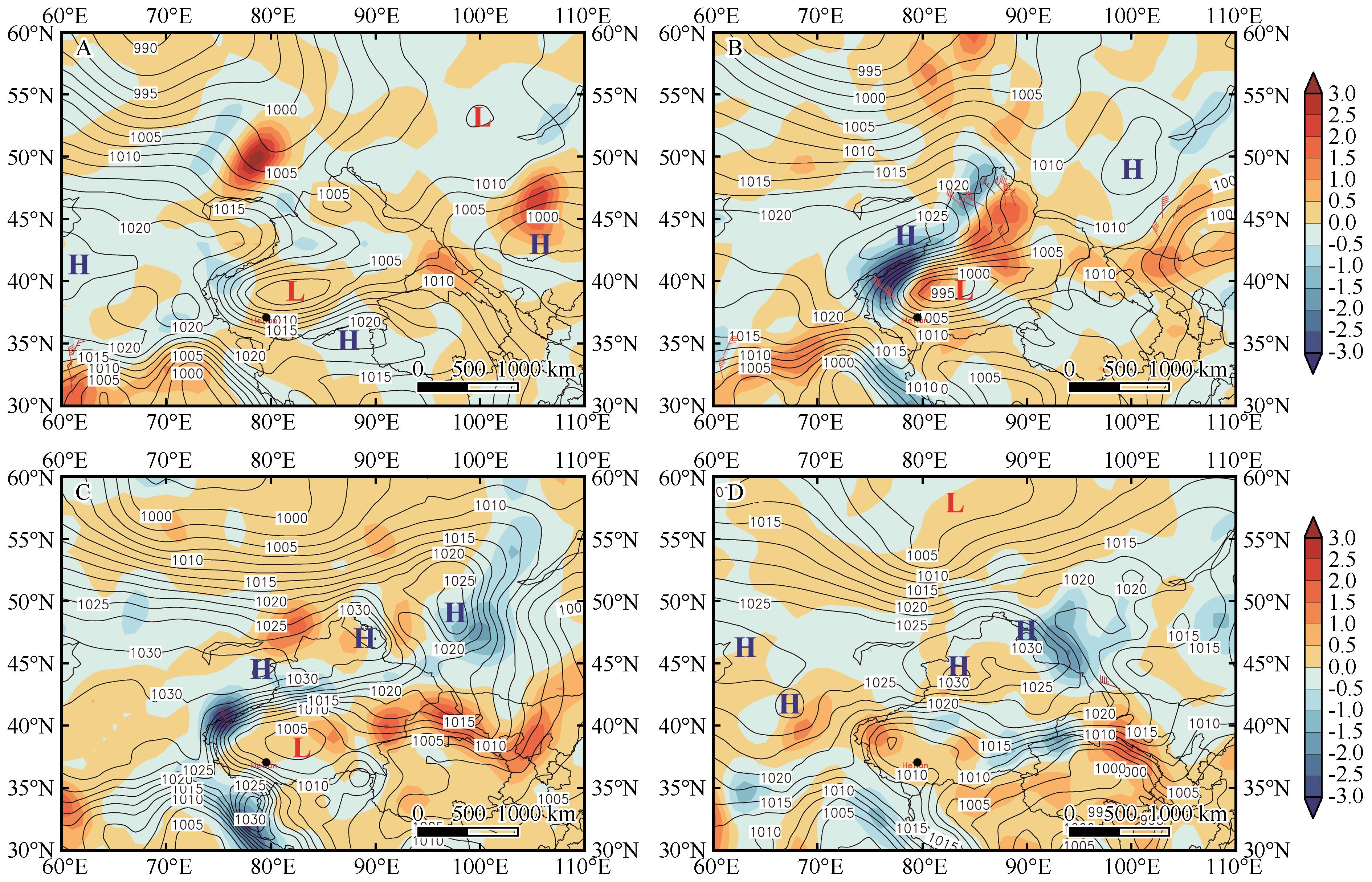
Fig.3 Sea level pressure field (isoline, unit: hPa), frontal function (shadow, unit : 10-5 K·m-1·s-1), surface gale(≥17 m·s-1) at 08:00 (A), 20:00 (B) on 9 June, 2015 and at 08:00 (C) , 20:00 (D) on 24 March, 2022
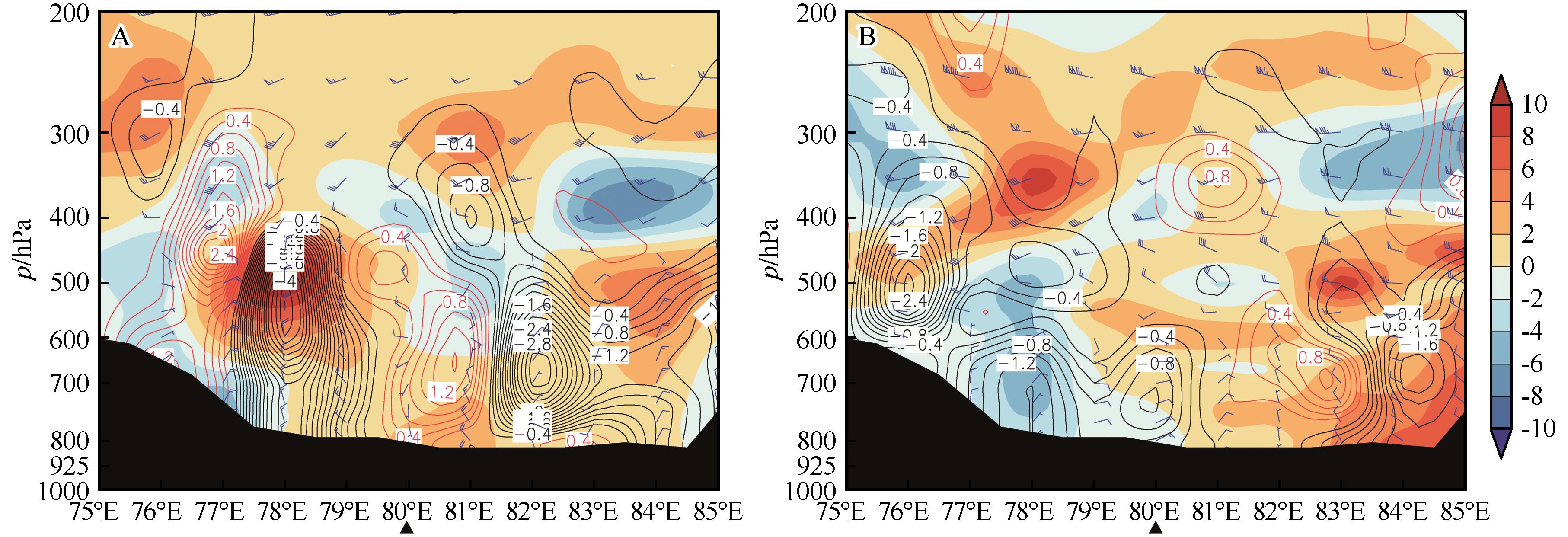
Fig.4 Vertical velocity (isoline, unit: Pa·s-1), divergence (shadow, unit : 10-5 s-1) and vertical wind profile along 37.13°N at 20:00 (A) on 9 June, 2015 and at 20:00 (B) on 24 March, 2022
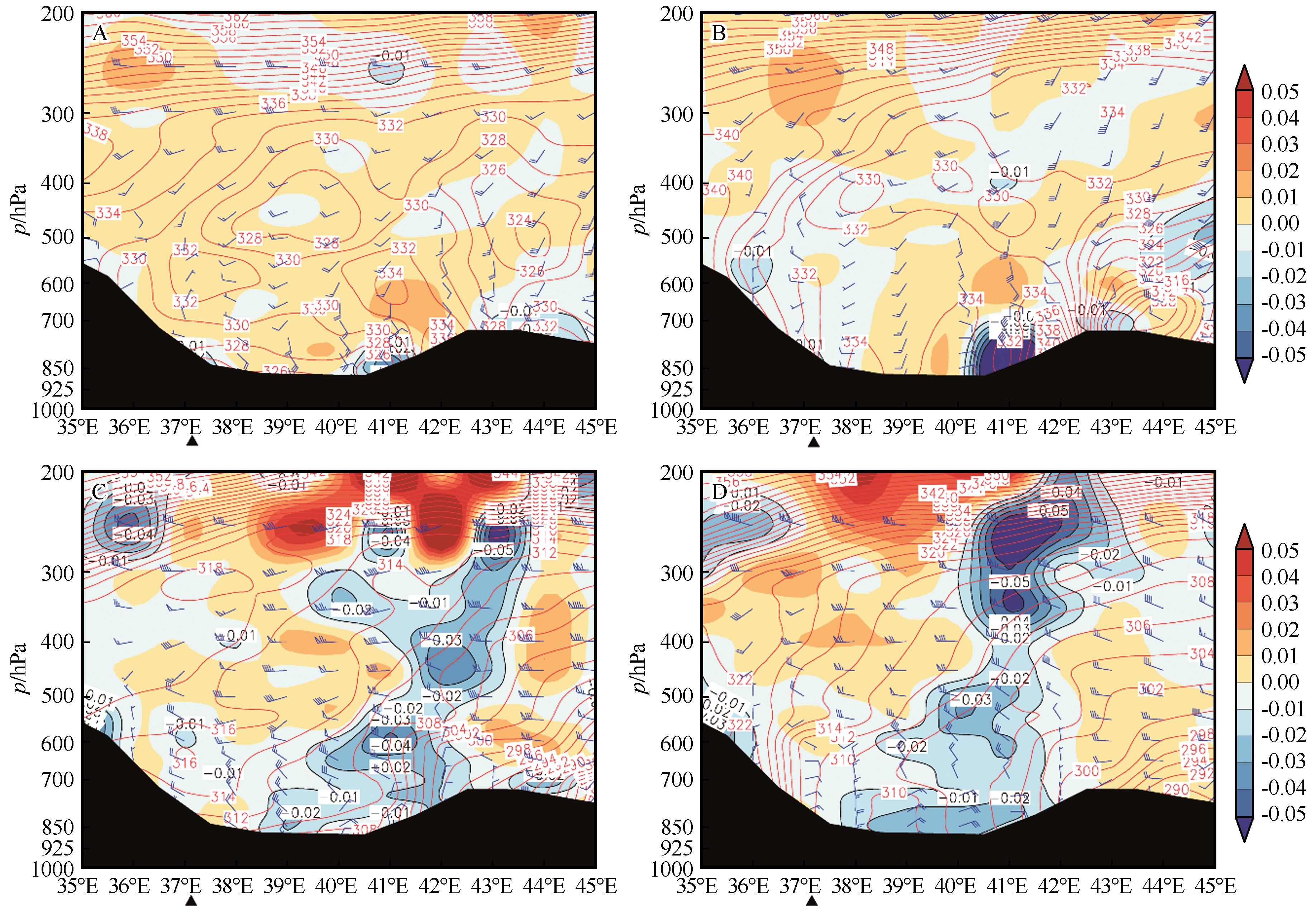
Fig.5 Temperature advection (shadow, unit : ℃·s-1), pseudo-equivalent potential temperature (red isoline, unit : K)and vertical wind profile along 79.93°E at 08:00 (A), 20:00 (B) on 9 June, 2015 and at 08:00 (C) , 20:00 (D) on 24 March, 2022
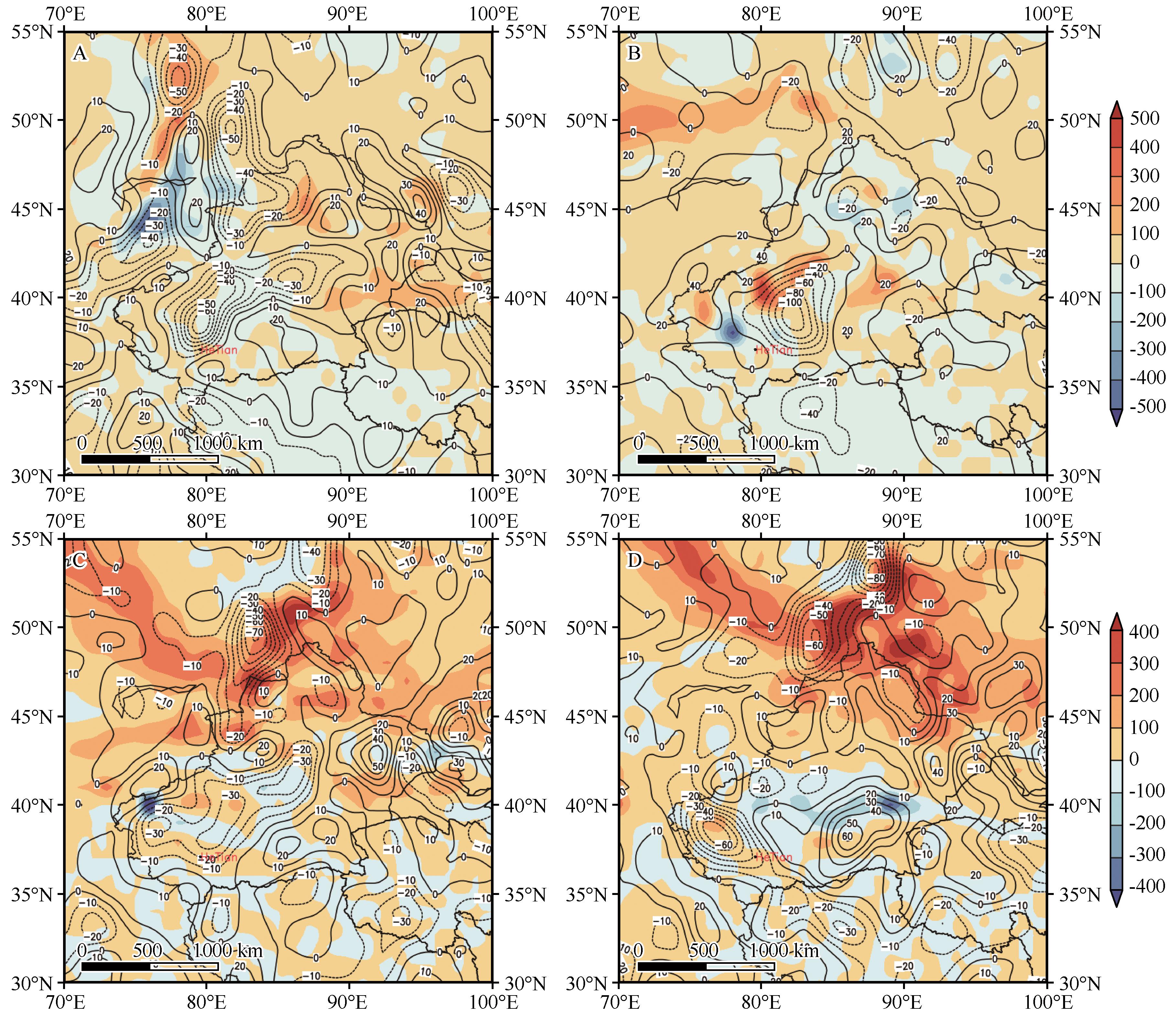
Fig.6 850 hPa divergence (isoline, 10-5 s-1), horizontal helicity (shadow, m2·s-2) at 08:00 on 9 June (A), 02:00 on 10 June (B), 2015 and at 08:00 on 24 March (C) , 02:00 on 25 March (D), 2022
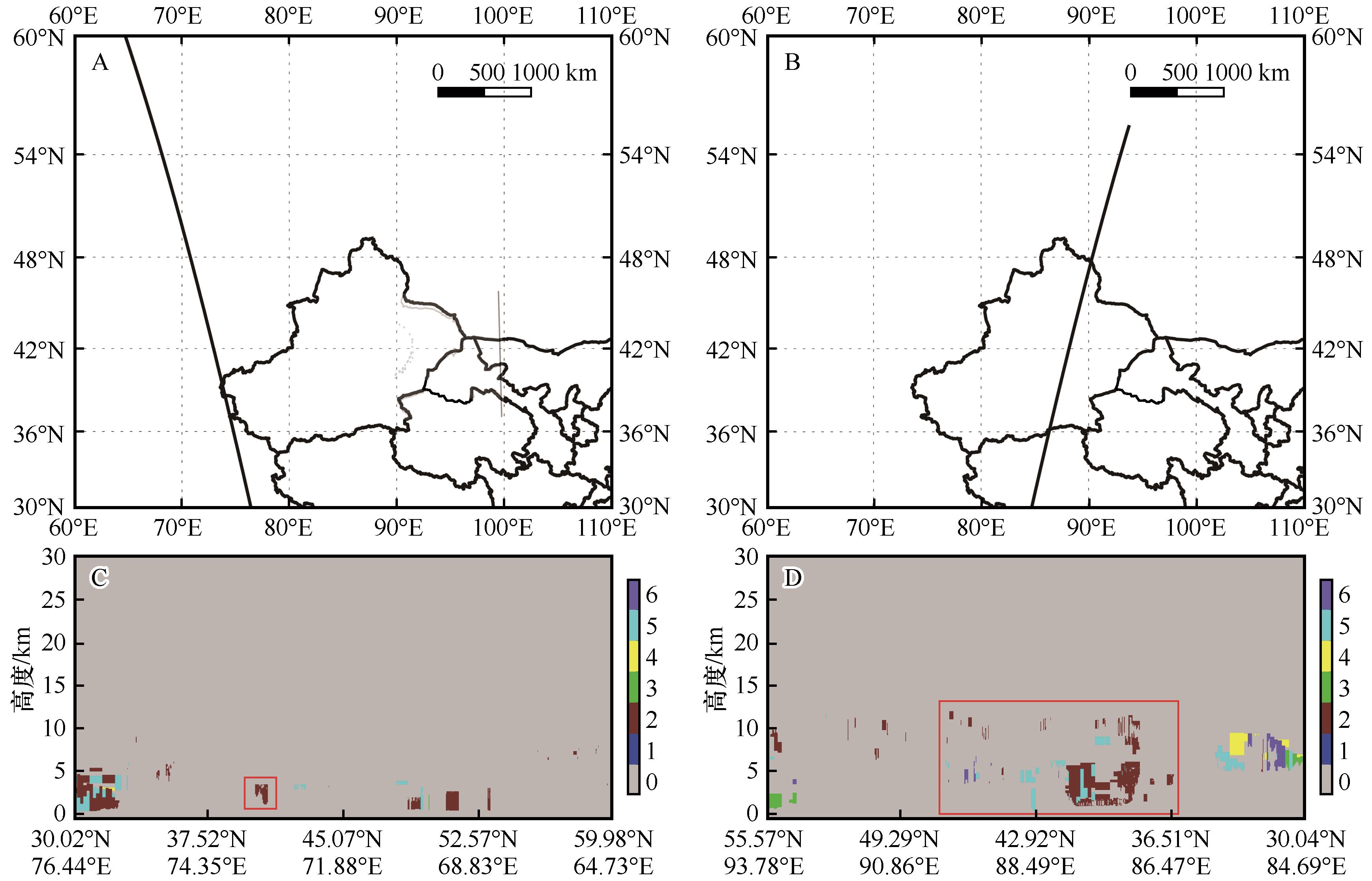
Fig.10 CALIPSO satellite trajectory (black lines) and aerosol vertical characteristics information at 15:53 on 9 June (A,C) and at 04:18 on 10 June (B,D), 2015
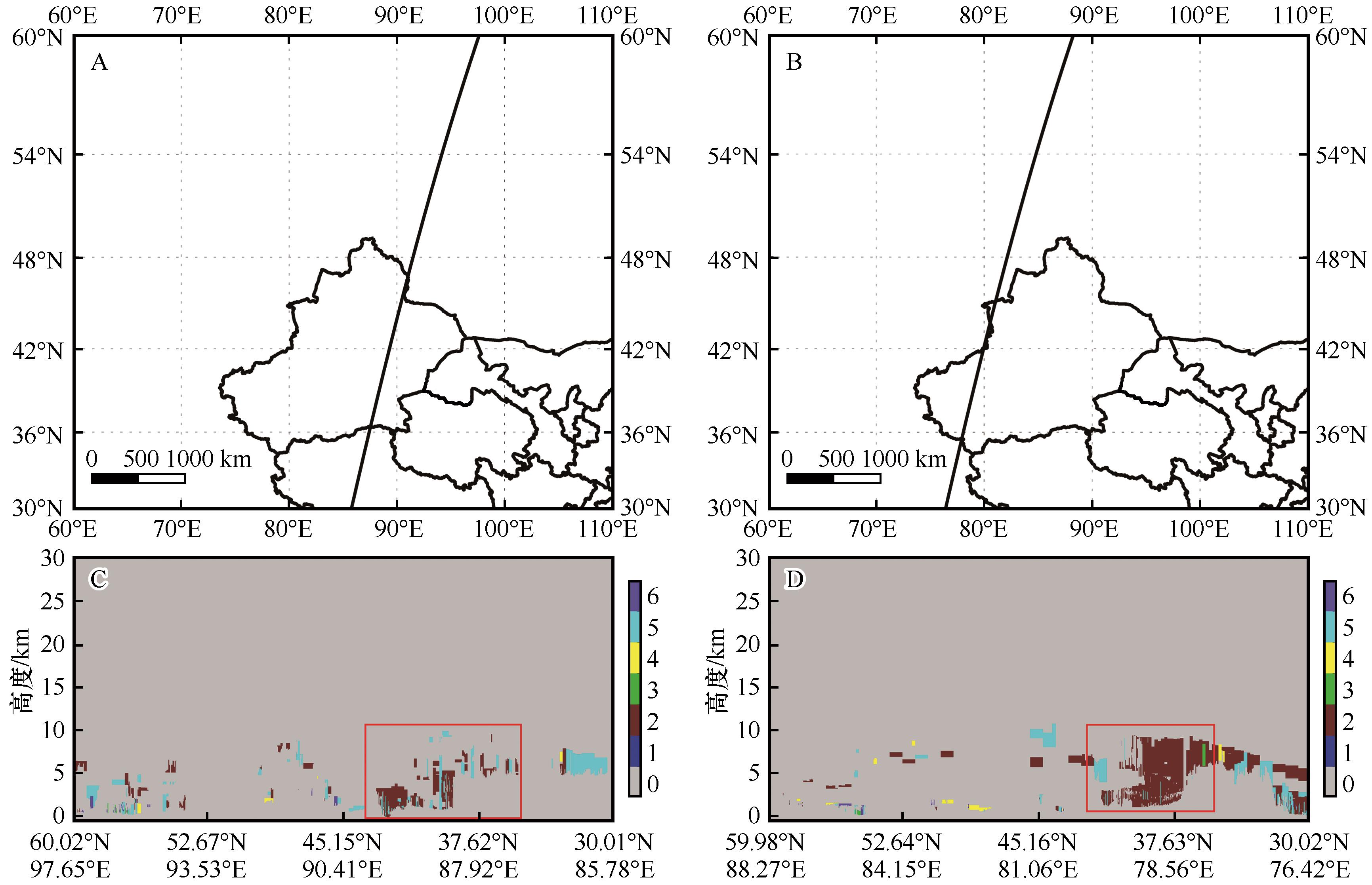
Fig.11 CALIPSO satellite trajectory ( black lines ) and aerosol vertical characteristics information at 05:06 on 25 March (A,C) and at 05:43 on 26 March (B,D), 2022
| 1 | 张强,王胜.论特强沙尘暴(黑风)的物理特征及其气候效应[J].中国沙漠,2005,25(5):675-681. |
| 2 | 刘明哲,魏文寿.南疆近60年来的气候变化及其对沙尘暴发生条件的影响[J].干旱区地理,2005,28(4):63-67. |
| 3 | 白冰,张强,陈旭辉,等.东亚三次典型沙尘过程移动路径和特征[J].干旱气象,2018,36(1):11-16. |
| 4 | 王华,轩春怡,吴方,等.北京两次重污染沙尘天气成因及动力传输特征的对比研究[J].沙漠与绿洲气象,2020,14(4):18-26. |
| 5 | Grigholm B, Mayewski P A, Kang S,et al.Twentieth century dust lows and the weakening of the westerly winds over the Tibetan Plateau[J].Geophysical Research Letters,2015,42(7):2434-2441. |
| 6 | 张莉,丁一汇,任国玉.我国北方沙尘天气演变趋势及其气候成因分析[J].应用气象学报,2005(5):583-592. |
| 7 | 孔锋.中国灾害性沙尘天气日数的时空演变特征(1961-2017)[J].干旱区资源与环境,2020,34(8):116-123. |
| 8 | 杨晓军,张强,叶培龙,等.中国北方2021年3月中旬持续性沙尘天气的特征及其成因[J].中国沙漠,2021,41(3):245-255. |
| 9 | 张璐,宋桂英,范凡,等.2021年3月14-16日中国北方地区沙尘暴天气过程诊断及沙尘污染输送分析[J].环境科学学报,2022,42(9):351-363. |
| 10 | 张小啸,陈曦,王自发,等.新疆和田绿洲大气降尘和PM10浓度变化特征分析[J].干旱区地理,2015,38(3):454-462. |
| 11 | 艾沙江•艾力,梁菲菲,徐海量,等.和田绿洲沙尘暴物质输送路径及其对大气环境质量的影响[J].环境科学学报,2020,40(8):2882-2891. |
| 12 | Yangh X H,Shen,S H, Yang F,et al.Spatial and temporal variations of blowing dust events in the Taklimakan Desert[J].Theoretical and Applied Climatology,2016,125(3/4):669-677. |
| 13 | Chen S, Tong B, Dong C,et al.Retrievals of aerosol layer height during dust events over the Taklimakan and Gobi Desert[J].Journal of Quantitative Spectroscopy and Radiative Transfer,2020,254(5468):107198. |
| 14 | 朱从祯.塔里木盆地浮尘的大气边界层结构和天气环流变化特征及盆地地形的影响作用[D].南京:南京信息工程大学,2022. |
| 15 | Hu J, Zhao T L, Liu J,et al.Nocturnal surface radiation cooling modulated by cloud cover change reinforces PM2.5 accumulation:observational study of heavy air pollution in the Sichuan Basin,southwest China[J].Science of the Total Environment,2021,794:148624. |
| 16 | Zhao X, Zhao C F, Yang Y K,et al.Dust aerosol impacts on the time of cloud formation in the Badain Jaran Desert Area[J].Journal of Geophysical Research:Atmospheres,2022,127(21):D037019. |
| 17 | Wang M Z, Wei W S, He Q,et al.Summer atmospheric boundary layer structure in the hinterland of Taklimakan Desert,China[J].Journal of Arid Land,2016,8(6):846-860. |
| 18 | 刘尊驰.南疆典型沙区沙尘天气发生发展规律研究[D].石河子:石河子大学,2016. |
| 19 | 文倩,关欣,崔卫国.和田地区大气降尘对土壤作用的研究[J].干旱区研究,2002,19(3):1-5. |
| 20 | 赵丹丹,关欣,李巧云,等.新疆和田降尘的时空分布与影响因子[J].新疆农业大学学报,2005,28(2):4. |
| 21 | 关欣,李巧云,文倩,等.和田降尘与浮尘、扬沙、沙尘暴关系的研究[J].环境科学研究,2000,13(6):1-3. |
| 22 | 张家宝.新疆短期天气预报指导手册[M].乌鲁木齐:新疆人民出版社,1986:360. |
| 23 | Draxler R R, Gillette D A, Kirkpatrick J S,et al.Estimating PM10 air concentrations from dust storms in Iraq,Kuwait and Saudi Arabia[J].Atmospheric Environment,2001,35(25):4315-4330. |
| 24 | Wang Y Q, Zhang X Y, Draxler R R.TrajStat:GIS-based software that uses various trajectory statistical analysis methods to identify potential sources from long-term air pollution measurement data[J].Environmental Modelling & Software,2009,24(8):938-939. |
| 25 | 汪蕊,丁建丽,马雯,等.基于PSCF与CWT模型的乌鲁木齐市大气颗粒物源区分析[J].环境科学学报,2021,41(8):3033-3042. |
| 26 | 陈乃华,胡宝叶,杨玉香,等.基于后向轨迹的平潭大气污染输送来源研究[J].环境污染与防治,2019,41(8):938-945. |
| 27 | 张敬巧,罗达通,王少博,等.聊城市秋季PM2.5中水溶性离子污染特征及来源解析[J].环境工程技术学报,2021,11(4):617-623. |
| 28 | 孙永刚,孟雪峰,荀学义,等.温度平流在沙尘暴和大风天气预报中的差异分析[J].气象,2014,40(11):1302-1307. |
| 29 | 李岩瑛,张强.水平螺旋度在沙尘暴预报中的应用[J].气象学报,2012,70(1):144-154. |
| 30 | 钱正安,蔡英,刘景涛,等.中蒙地区沙尘暴研究的若干进展[J].地球物理学报,2006(1):83-92. |
| 31 | 钱正安,宋敏红,李万元.近50年来中国北方沙尘暴的分布及变化趋势分析[J].中国沙漠,2002,22(2):10-15. |
| [1] | Junhe Liu, Yunping Chi, Yuanyun Xie, Chunguo Kang, Zhenyu Wei, Peng Wu, Lei Sun. Geochemical characteristics of Songnen Sandy Land and its indication of contribution to aeolian dust [J]. Journal of Desert Research, 2023, 43(3): 252-263. |
| [2] | Ming Zhao, Chunxiao Zhou, Chong Li, Shuo Liu, Hujia Zhao. Temporal-spatial distribution of sand dust intensity during 1960-2020 in Liaoning [J]. Journal of Desert Research, 2022, 42(2): 113-120. |
| [3] | Yang Yanping, Wang Lina, Yang Lili, Tao Huijie, Jiang Lin. Air pollution characteristics and potential sources in Lanzhou during dust weather [J]. Journal of Desert Research, 2020, 40(3): 60-66. |
| [4] | Jiang Yingsha, Gao Yanhong, Pan Yongjie, Li Xia. Spatial and Seasonal Distributions of Sand Dusts in Qinghai-Tibet Plateau and Its Surrounding Areas [J]. Journal of Desert Research, 2019, 39(4): 83-91. |
| [5] | Li Danhua, Long Xiao, Wen Xiaopei, Jiang Yin, Meng Xiaowen. Influence of Underlying Surface on Dust Weatherin the Entrance of the Hexi Corridor [J]. JOURNAL OF DESERT RESEARCH, 2017, 37(6): 1210-1218. |
| [6] | Li Zongjie, Song Lingling, Tianqing. The pH and Electric Conductivity of Precipitation and their Indicative Significance of Sand-dust Weather in Wuwei, China [J]. JOURNAL OF DESERT RESEARCH, 2017, 37(3): 546-553. |
| [7] | Zhou Deping, Hong Ye, Wang Yangfeng, Liu Ningwei, Zhang Yunhai, Li Liguang. Observation on Distributions of Atmospheric Ice Nuclei Concentration and Size under the Influence of Dust Weather [J]. JOURNAL OF DESERT RESEARCH, 2016, 36(6): 1672-1678. |
| [8] | Qian Li, Yao Yubi, Yang Xin, Liu Juju. An Analysis of Sandstorm Weather Process in the Hexi Corridor in Summer [J]. JOURNAL OF DESERT RESEARCH, 2016, 36(2): 458-466. |
| [9] | Lin Zhiqiang, Wang Pengxiang, Tang Shuyi, Zhou Zhenbo, Yang Limin. Climate and Circulation Characteristics of Dust Weather in Gonggar, Tibet, China [J]. JOURNAL OF DESERT RESEARCH, 2015, 35(5): 1312-1319. |
| [10] | LI Yi-ping1, DELE Gerima1,2, SI Qin1, WU Xue-hong1. A Synoptic Analysis on Forecasting of Sand-Dust Storm in November over Inner Mongolia [J]. JOURNAL OF DESERT RESEARCH, 2013, 33(5): 1483-1491. |
| [11] | CHEN Yi1,2, SHANG Ke-zheng1, WANG Shi-gong1, LI Yan1, XIONG Guang-jie1. Characteristics of Sand-dust Weather and the Relationship between Land Surface Conditions and Sand-dust Weather in Semi-arid Region of Inner Mongolia, China [J]. JOURNAL OF DESERT RESEARCH, 2013, 33(4): 1131-1137. |
| [12] | LIU Xin-chun1,2, ZHONG Yu-ting1,2, HE Qing1,2, PENG Yan-mei1,2,3, LUO Xiao-ru4. The Variation Characteristics and Influencing Factors of Surface Ozone Concentration in the Taklimakan Desert Hinterland [J]. JOURNAL OF DESERT RESEARCH, 2013, 33(2): 626-633. |
| [13] | CHEN Yi1,2,SHANG Ke-zheng1, WANG Shi-gong1, Li Yan1. Characteristics of Sand-dust Weather in Northern China from 2002 to 2010 and Its Relationship with Surface Wind Speed and NDVI [J]. JOURNAL OF DESERT RESEARCH, 2012, 32(6): 1702-1709. |
| [14] | LIU Xin-chun, ZHONG Yu-ting, HE Qing, YANG Xing-hua, AI Li-·Mai-mai-ti-ming. Vertical Distribution of Dust Aerosol Mass Concentration in Hinterland of the Taklimakan Desert [J]. Journal of Desert Research, 2012, 32(4): 1045-1052. |
| [15] | HUO Wen;HE Qing;YANG Xing-hua;ZHAO Yong;WANG Shi-gong;LI Yao-hui. Characteristics of Sand-dust Weather over Kumtagh Desert during 2007—2008 and the Weather Styles [J]. JOURNAL OF DESERT RESEARCH, 2011, 31(4): 1037-1045. |
| Viewed | ||||||
|
Full text |
|
|||||
|
Abstract |
|
|||||
©2018Journal of Desert Research
Tel:0931-8267545
Email:caiedit@lzb.ac.cn;desert@lzb.ac.cn
Support:Magtech